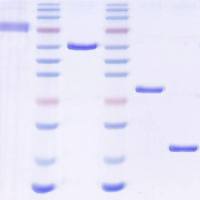[D-Arg6, D-Trp7,9, NmePhe8]-Substance P (6-11) Activates JNK and Induces Apoptosis in Small Cell Lung Cancer Cells via an Oxidant-Dependent Mechanism
互联网
823
[D-Arg6 , D-Trp7,9 , Nme Phe8 ]-substance P (6-11) (antagonist G) is a novel class of anti-cancer agent that inhibits small cell lung cancer (SCLC) cell growth in vitro and in vivo and is entering Phase II clinical investigation for the treatment of SCLC (1 ,2) . Although antagonist G blocks SCLC cell growth (IC50 = 24.5 � 1.5 and 38.5 � 1.5 μM for the H69 and H510 cell lines, respectively), its exact mechanism of action is unclear. Factors affecting the balance between SCLC cell proliferation and apoptosis will have a profound effect on tumor growth. However, the mechanisms which regulate apoptosis remain poorly understood. The p46/p54 c-jun N-terminal kinases (JNKs) are members of the MAPK family that activate the transcription factors c-jun and ATF2 and are stimulated by environmental stress (e.g., heat shock, UV, TNF-α), receptor tyrosine kinases and G-protein-linked receptors (3 -5) . Activation of JNK1 has been shown to be important for UV-induced apoptosis in SCLC cells (6) . Reactive oxygen species (ROS) are involved in signaling events leading to apoptosis in many cell types (7) . ROS have been shown to activate JNK (8) , c-jun expression, and AP-1 activity (9 ,10) . The role of ROS in pathways leading to programmed cell death is particularly pertinent in cancers where the oxygen tension at the center of tumors may be particularly low (11) .










